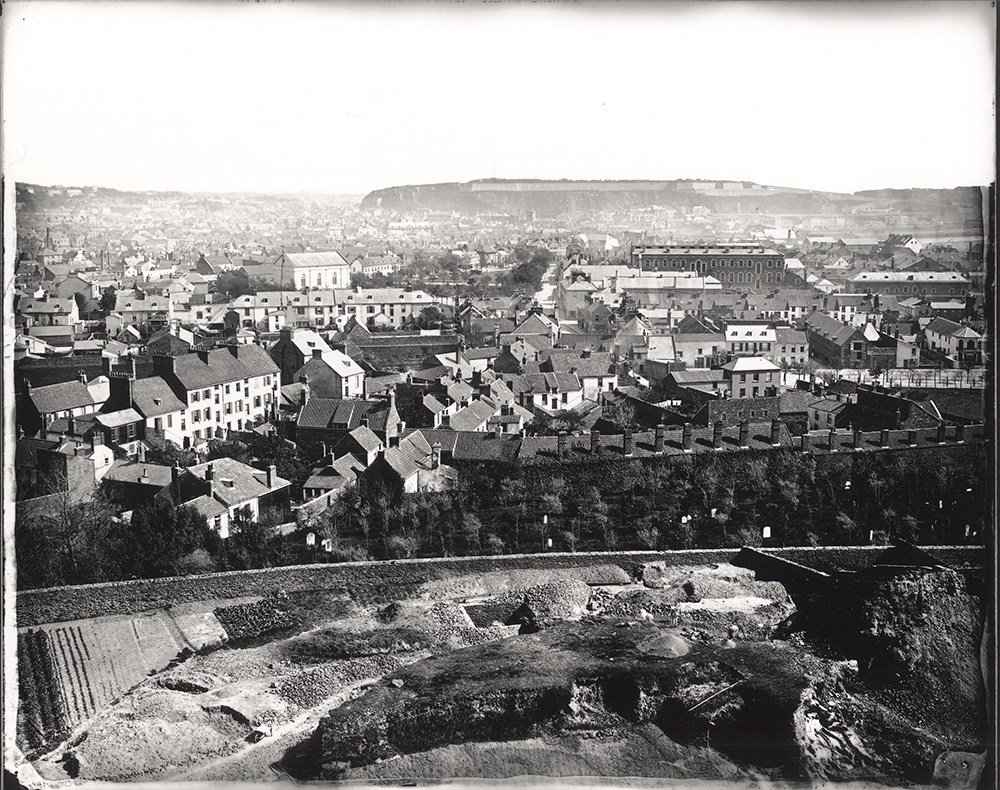





Category Archives: Developing
Filters
My Archival Images

Extra reading from books of the sublime
A philiosophical enquiry – by burke – oxford
Burke had the through that the beautiful us that which is well-formed and aesthetically pleasing. And differently how the sublime is something which has power to compel and then destroy us. He stated the difference was that of the transition from neoclassical to the romantic era. Burkes thinking was based off the understanding he had from the casual structures, this consisting of Aristotelians belief that ‘physics and metaphysics, causation can be divided into formal, material, efficient and final causes’ he believed the formal cause of beauty if the passion of love, the material cause concerns would be the materials of the object itself, smallness, smoothness, delicacy. These intern cause the calming of our nerves . The final cause is God and his providence. Beauty before burkes view was based on the three defining factors of fitness perfection and proportion. however the sublime also had a casuals structure before Burkes theory and this consisted of, the passion of fear(death), The material was the infinity, vastness and magnificence of the object. The efficient cause is the tension of our nerves, and gos role in the final cause is having created and battled satan.The themes within this book contain 4 main propositions throughout the novel itself, these consist of:
childishness: these are shown through the study of aesthetic requires to move beyond an implicit appreciation of the attractive elements of the world around them. burka himself acknowledges this fact through the establishment of childishness as a theme of his work. the childlike elements is substantial to the way he wrote without insulting great thinkers but his concern with he topic to be presented without inflicting or proving others to be wrong. The next is;
Classification: this is when Burke proceeds throughout his work using classifications. In particular, the theme of classification is permeated by the question of independence or dependence in the sensations about which he writes, as well as new connections and differences between objects and parts of life.
Humanism: burkes work focuses primarily of the beautiful and the sublime. although he soon redirects the attention to the paradigm of the self with the theme of humanism. he speaks about the placing of emotions within the personal realism. When studying terror burke evoked the sensation about which he writes, allowing the reader to maintain a childlike sense of observation and reminds ourselves that is the reason for the book itself if comprehension and appreciation. To my mind this has clear connotations of the way in which he has an emotional sensitivity when dealing with others and even talking about the harsh emotions considered with that of beauty and the sublime.
Aesthetics: enquiry is said to lead a reader to notice emotions. Burke is said to concern himself with the theme of aesthetics. The theory itself is a wide-ranging and many have attempted to define why we take pleasure of of certain scenarios of what we notice in the natural and sensory world. He develops on many of these themes with calmness and rarely becoming carried away. He talks about aesthetics throughout the novel, stating things such and . Burke argues in Reflections on the French Revolution, such rights are ‘by the laws of nature, refracted from their straight line’, enduring ‘such a variety of refractions and reflections, that it becomes absurd to talk of them as if they continued in the simplicity of their original direction’. What is natural about such rights is their deviance or aberrancy; their self-disseminatory power is part of their very essence. When Burke adds that ‘the nature of man is intricate; the objects of society are of the greatest possible complexity’, he speaks, in the original sense of the term, as an aesthetician. And this is equivalent, in this political context, to saying that he speaks also as a reactionary. Some quotes from reading the first beginning of the book that have really stuck with me are the following:people are not liable to be mistaken in their feelings, but they are very frequently wrong in the names they give them, and in their reasoning about them. pleasure does form the ceasing or diminution of some pain. pain and pleasure are each from a positive mature.
The sublime -contemporary arts – simon morleyth and this book is more of an in depth analysis to what the sublime is, means and how it was formed. For Longinus, the sublime is an adjective that describes great, elevated, or lofty thought or language, particularly in the context of rhetoric. As such, the sublime inspires awe and veneration, with greater persuasive powers.
research: Comparison of manifesto, animal farm and surrealism Andre Breton
what is a manifesto? a manifesto is. verbal declaration of intentions, motives,views and issuer, this could be seen within creativity making a creative video of art, or either a political party and a governmental movement. It is derived from the meaning of clear and conspicuous. This to my mind means my manifesto has to have clear cut conventions and portray a clear and genuine state of mind. There are many art movements that contextually produces a variety of opinions and aims.
political manifesto: The political manifesto that I have researched into is ‘Animal Farm’ by George Orwell’ Animal farm is a paradigm-changing novel written by the democratic socialist and observer writer George Orwell is a satire aimed at undermining Stalin and, as crucially, the admiration in which he was held by many in the British intelligentsia. The story is led by two pigs napoleon and snowball, they have the intentions to take over major farm with the act of revolution in order to run so in a new name of equality. Napolean is seen to drive away Snowball and strive through abandoning their previous pans of social improvement. He starts to work other animals to dust and is soon seen to be a direct carbon copy of that of the farmer. The key phrase of the book is when it is displaced that “all animals are equal” , “but some are more equal than others” . This story It highlights the morals of byword for how Stalinism worked and was practised. And due to this manifesto it snuffed the political chances of the British communist party of being a large political force.
It is interesting because although animal farm was not written in the form of a normal political manifesto,but a novella short story. Yet it was still written in order to compare the ideals expressed in the novellas compared with the fundamentals of communist manifesto written by Karl Marx. The story reflects a period during Stalin era in Russia. Many of marx’s ideas can be found in Orwells character, this is because Orwell had an influence wihtin Marx’s text. Karl Marxs manifesto Is said to be ‘worlds most influential political manifesto ever created’. this has been said as it argues:the lower classes are under pressure of their owners and that the lower class can be able to achieve their goals to overcome their problems by the formation of unions or riots. It also states the capitalism should be overthrown because communision is the only way for equality among the people. In the third section of the Communist Manifesto, “Socialist and Communist Literature,” the authors discuss the differences of communism and other socioeconomic systems. In their conclusion, “Position of the Communists in Relation to the Various Opposition Parties,”The Communist Manifesto is divided into a preamble and four sections. the main issues wihtin the manifesto was: In capitalism, the industrial working class, or proletariat, engage in class struggle against the owners of the means of production, the bourgaeaie As before, this struggle will end in a revolution that restructures society, or the “common ruin of the contending classes” HIs views on political issues to summerssise where how if poor pope;le keep being treated and overpower by the corrupt and Conservative party,they will rebell in order to abolish the class system. he believed the idea of equality and founded Communism,yet his theories were seen distorted by those in high class powers making no real change to those who needed it.
now the comparison of animal farm and Karls manifesto is evident. and clear seen below:
RUSSIAN REVOLUTION1) Oppressed by the Russian Empire before the Russian Revolution
2) Karl Marx was widely recognized by his knowledge and philosophies3) Marx wrote the “Communist Manifesto” which recorded his principals and theories of abolishing the class system. 4) Marx’s “Communist Manifest” is convinced to be what Communism is based on. The idea of equality motivated Stalin and Lenin to start the Russian Revolution, which overpowered the Russian Empire. 5) However Karl Marx did not live to see the Russian Revolution that took place in 1917. He was then buried in Highgate Cemetery, North London. 6) After the Russian Revolution, Karl Marx’s theories were distorted by Stalin, the Soviet dictator. He manipulated the people of the Soviet Union with violence and cruelty. |
ANIMAL FARM1) Oppressed by Mr Jones before the rebellion of the animals on Maor Farm
2) Old Major was a ‘highly respected’ boar by all the animals in the farm. 3) Old Major expressed his initial idea for all animals to rule and live freely through his speech in the ‘big barn’ 4) Animalism convinced the animals that they are being oppressed by humans, and roared with their “wildest excitement” Major’s speech then inspired Snowball and Napoleon to initiate the rebellion against Mr Jones. 5) Old Major died ‘three nights later’ without having the chance to witness the animal’s revolution. The animals buried his body at ‘the foot of the orchard’ 6) After the animal’s revolution against Mr Jones, Napoleon took charge of the Animal Farm. He abandoned the initial ideas that Old Major proposed, and corrupt the principles of Animalism. |
Now this was the most influential political manifesto ever to be created, yet was still abolished and twisted due to governmental powers guaranteeing a set of rules and yet not being compliant. This to me purposes the overall ideal that political manifestos are what the people want to be done yet are not taken into action. I believe when comparing to my more creative art manifesto this will be the large difference; that being the outcome and if the manifesto becomes a reality.
artistic manifesto: As I myself view art as my passion dn would hope to see a future career wihtin it, I personally believe artistic manifestos should be held to the same level of important as those of political manifestos. When researching two features of contextual art movements instantly stood out and these were, surrealism and futurism.The manifesto of surrealism is was written in 1924 by Andre Breton, and comatained 5 main aims and contextual ideas wihtin so. This consisted of:
- how not to be bored in company
- how to make speeches
- how to write false novels
- how to catch the eye of a woman on the street
- against death
He believed that belief in life is the most precious aspect of life itself, by which is meant for real life. He lived people were inveterate dreamers who were disconnected by operating of fate and how no matter his efforts he has been consented to labour. he images surrealism to be a man who ‘remains in this respect a new-born babe, and as for the consent of his moral conscience, I admit that he does very well without it. If he retains any degree of lucidity, he can do no more than turn to his childhood, which ruined as it has been by his teachers’ pains, seems to him nonetheless full of charm.’Breton is said to say’ Dear imagination, what I love most about you, is your unforgiving nature.’
this artist has four main reasons to which he operates and why he created his manifesto, 1, within the bounds in which they operate dreams continuously show a sign of order. Memory arrogates and it is important to ignore these transitions. We must have many dreams, a series of dreams and represent ourselves through a dream itself. Secondly being awake should be considered a phenomenon. Not one he has said’Not only does the mind display, in this state, a strange tendency towards disorientation (a tale of lapses and errors of all sorts the secret of which is beginning to be revealed) but what is more it seems that when the mind is functioning normally it does no more than respond to suggestions which come to it from the depths of that night to which I commend it.’ Thirdly, our spirit of those who dreams is content with that which happens to him. you need to live, fly and love to your herts content. If you die you do not know what will happen,re you certain to wake among the dead? we haven name we should be led. And lastly if someone fails it is because they have led to accept an impoverished idea of expiation. mystery and moment should be in san and make a future resolution. ]The artists then makes many poems about his work which I will further look into with future analysis.
comparison:
The differences to me between a political and artist manifesto is the way in which the intentions are written and carried about, On the political side they are said to point out injustice and make a claim to help change and create a new world. Whereas art is an exploration of who we all are,Not just negative but who we want to be and how we should go about doing so. It is written more so as a conceptual brainstorm of our imagination of the people who we would like to see ourselves as. To my mind, art is about changing yourself and not the opinions of others around yours to me I feel is less corrupt and more likely be be accomplished, rather than the broken promises of the political manifestos. However I will still in a similar way to those of political manifesto ideals but I will carry on the surrealism promises that I have been previously discussing.
The Rule of Technicality
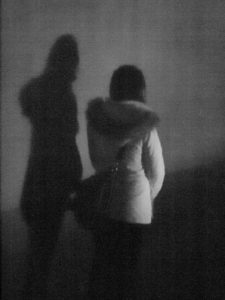
The word ‘rule’ is defined as one of a set of explicit or understood regulations or principles governing conduct or procedure within a particular area of activity. This shows that the word rule is linked to control and standards – rules govern what we should and shouldn’t do. When looking at photography, the rules can often be what is acceptable to photograph and what is not, where a subject should be placed, and which camera settings should be used to capture the technically correct photograph. Below is the origin for the word ‘rule’. It originated from the latin word ‘regula’ for ‘straight stick’ and progressed through French in order to come around in the Middle English language.

The word ‘technicality’ is defined as ‘a point of law or a small detail of a set of rules, as contrasted with the intent or purpose of the rules.’ This shows that technicality links into rules as they are small details which should be set a certain way in order to stay in line with the rules governing. In terms of photography, this is the settings of the camera; the ISO, the shutter speed, the aperture and the exposure. The technicalities and rules of camera settings suggest that photographs should be exposed correctly, be in focus and be aesthetically pleasing but technicalities can be changed in order to challenge these rules.
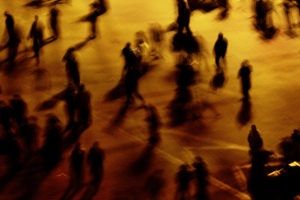
In Lewis Bush’s article ‘Rule Breakers‘, he explores eight rules within photography that are worth breaking. One of these rules is the rule of technicality. Bush says that “the camera technology of today means the real skill and the real statement sometimes lies in taking a wilfully ‘bad’ image”. By saying this, Bush is trying to convey the idea that it is alright to go outside the conventions of ordinary camera settings in order to create experimental photographs that would not normally be deemed aesthetically pleasing, but by using unique technicalities, photographers and artists such as Laura El-Tantawy and Henrik Malmstrom have used these technicalities to show creative expression. For example, El-Tantawy renders photographs of the Egyptian revolution with long exposures to express a personal vision of the event. El-Tantawy says “It was about responding spontaneously to the events around me” when speaking about the photographs as they showed what she felt and what she saw in the moment.
Ideas For Exploration

Whilst exploring the rule of technicality I will be looking at altering camera settings to create unconventional photographs that are both interesting and unique. I can take inspiration from both El-Tantawy and Henrik Malmstrom for this investigation as they both create unique and unconventional photographs. I think that Malmstrom has a very interesting approach in his book ‘A Minor Wrongdoing‘ in which he photographs subjects at night with a very high ISO to create grainy and underexposed photographs so I will continue to study Malmstrom. I will be able to explore street photography/documentary photography through this whilst also exploring the people within Jersey. Whilst doing this I can also look at creating out of proportion photographs or ones which do not consist of a conventional composition to further explore the idea of breaking the rule of technicality.

Whilst focusing on taking inspiration from Malmstrom, I may also look at changing technicalities which Malmstrom did not, such as shutter speed and aperture in order to make my photographs more unique and interesting. I hope through exploring this that I will be able to show my understanding of the rule of technicality and my understanding of the camera technicalities and conventions.
Edits of three locations on first shoot:
My inspiration for editing was to exaggerate the emotion possessed throughout the subject and landscape, either through colouring, or more conceptual editing of shape and overlapping of colour.My chosen images editing:
Happiness

I chose to edit many of these images into black and white as it highlights a simplicity and exaggerates the natural light from the sun itself. I though due to the interesting composition of this images that I would add some interesting conceptual shapes in order to provoke more thought to the image itself. Due to this person having a positive connection to this landscape I wanted to express a naivety and exaggerate an ignorance is bliss type of feel. To my mind the circles connote a display of balancing work,oppitunities and commitments and the lines symbolises rising and becoming better and more connected to yourself and not worrying about political ideologies to consume us when in surrounded by our favourite landscape. The shapes also mimic the simplicity and provoke a ignorance is bliss quality. I believe it is evident that this shoot is more concentrated towards happiness and timelessness also mimicked throughout he free and life full movement of the dress.
 Within this image I think I have successful caught the light and captured the movement of the dress itself, this personifies the dress to form a positive entity and a sense of freedom. Perhaps to this person this landscape to them is freedom and a place in which they can escape the governmental oppression to which they might face elsewhere.
Within this image I think I have successful caught the light and captured the movement of the dress itself, this personifies the dress to form a positive entity and a sense of freedom. Perhaps to this person this landscape to them is freedom and a place in which they can escape the governmental oppression to which they might face elsewhere. 

When experimenting with he images love I wanted to see how colour effects our emotions and so the effect to which we think about a photo and so what feel it ultimately communicates. I experimented within the saturation and also the conceptual contrast of vibrancy to show a sense of life, freedom and happiness.






anger

I decided the best way to convey anger would be through a darker ampeture and also a colour which clearly symbolises the emotion,this being red. I went to areas which show qualities of small confined spaces and making the subject feel small and powerless. I believe this successful demonstrates how they feel due to the way she is not allowed to make her own decisions but is powered by a governing group of higher people. The harshness of the rocks show an emotionless extent to which emphasis the governing bodies as being cut throat and an ignorance to peoples emotions and well being. 

Whever I have used a lighter tonal shade it is to highlight the irony to the possible future but that is kept through the bars of where she is. This is to communicate the opportunities not given to those depending on their social state ( poor education, not having enough money to pay for school)
 I wanted to use typical characteristics that you would find in a prison to once again emphasis the anger against the powerless state she and her family have been reduced to, due to having no choice in what happens to their future and money.
I wanted to use typical characteristics that you would find in a prison to once again emphasis the anger against the powerless state she and her family have been reduced to, due to having no choice in what happens to their future and money.



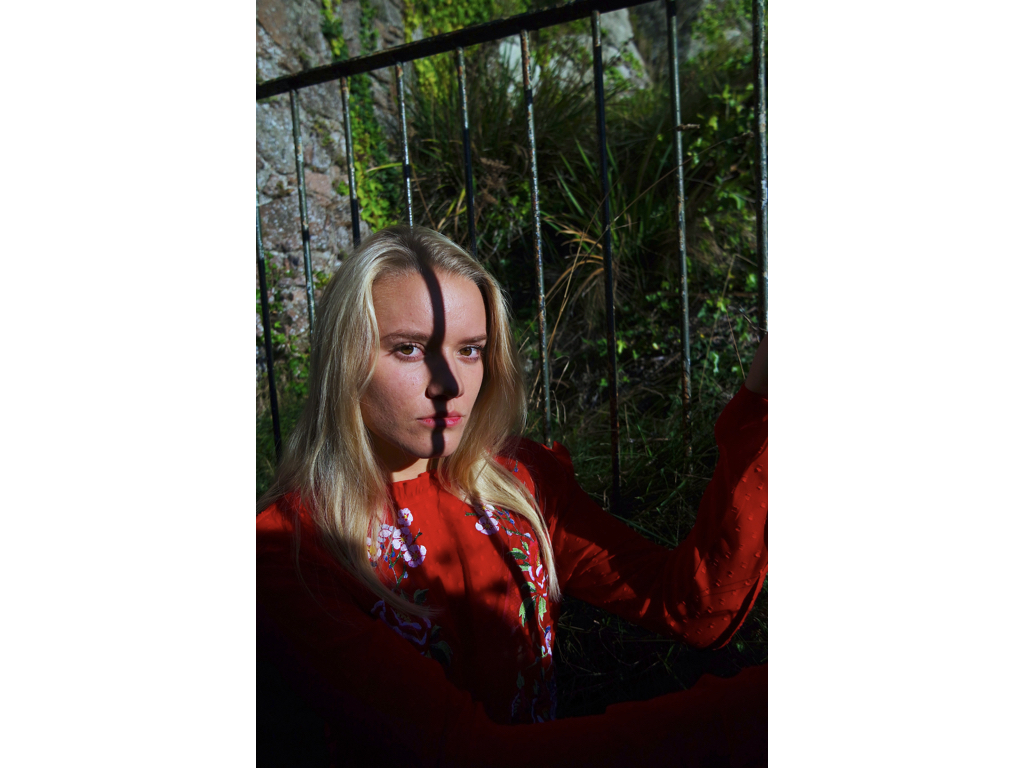

My Edits Of My Response To Political Landscapes
I have chosen to use the technique of pasting and cropping photographs over a base photographs and placing them in different places in order to align with the base photographs in order to create an interesting and contrasting composition. This allows me to be creative with the selection and placement of the photographs in order to emphasise as much as possible the differences and similarities between the past and present uses of the land. I will also be incorporating technique 3 into this by using natural frames such as mirrors and windows around the house in order to provide a more personal and interesting touch by showing how the fashion and style of property design has changed through time.
In order to provide myself with more photographs/frames to work with I have conducted an additional mini photoshoot within my household in which I photographed more frames and decorations within the house. I can use these photographs to broaden the variety of edits in my final outcome and to further show the current fashion and style within households.


In the edits I have used photoshop to alter/crop the montage photographs or archival photographs to fit within the natural framings that I photographed around my household and then placed the montages within the frame. I have done this to create a sense of personalisation within the edits as well as delving deeper into the theme of political landscape by showing how the inner decoration of the land changes over time, as well as the buildings themselves. The mixture of new and old photographs along with the modern decorations allows for the changes and developments over time to be shown as clearly as possible.
The majority of the photographs show the different sections of the houses and their developments through the use of montages but I have devoted one of the photograph edits to only the archival images within the frame in order for these photographs to be appreciated as they are without the contrast with the new photographs distracting the viewer from it. I have also included an edit which shows an archival photograph of me and my dad on the property in order to show that political landscape includes how the people involved in the change of land develop.

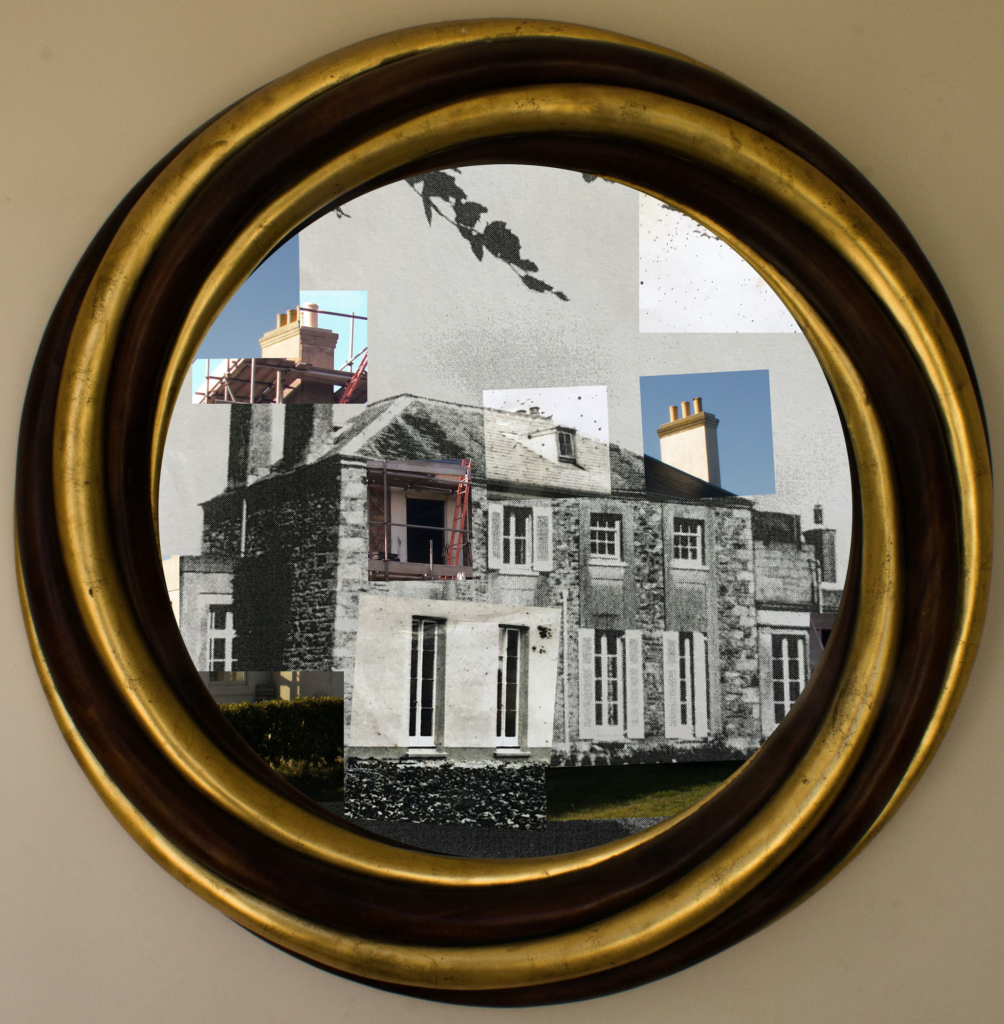



Analysis
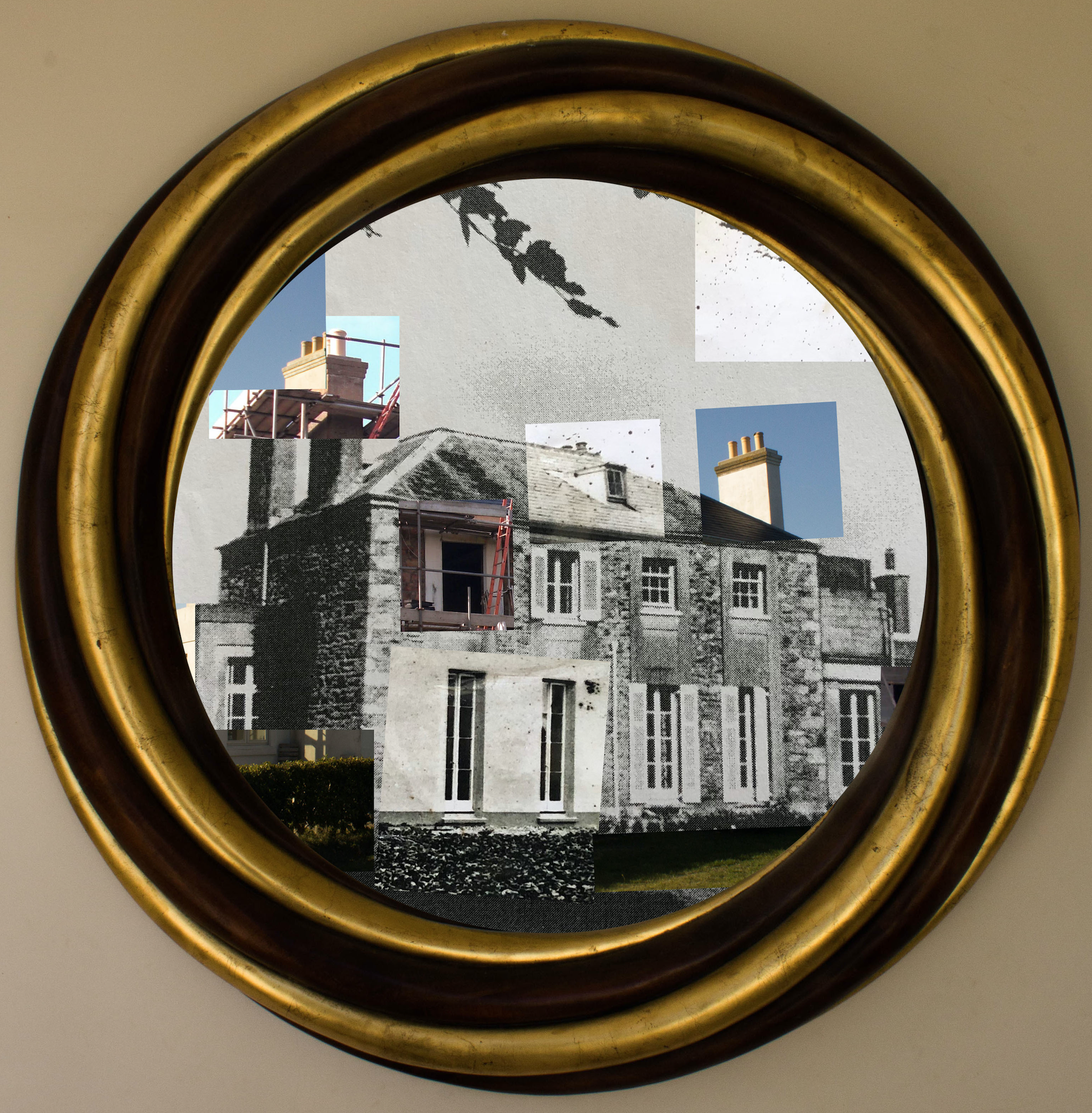
In this photograph natural lighting was used in all aspects from the photograph of the frame to the photograph of the house from 1873. This use of natural lighting has allowed for the natural shadows of the structure to be shown which helps to create contrast between the different shapes and angles in the structure of the house. There is a very wide tonal range in this photograph due to its montage nature – the bright white paint of the newly refurbished house contrasts against the black hole that is the window being renovated, this helps to create multiple viewpoints and areas of interest of which all contrast with eachother. A deep depth of field is used for all of the photographs involved in this montage as the whole of the photograph is in focus which allows for all the small details of the contrasts between the old and new to be seen. A shutter speed of 1/50 was used to capture the mirror frame along with an ISO of 200 as I wanted the frame to be of as high a quality as possible in order for it to compliment the photographs within it. For the photographs within the frame a slightly quicker shutter speed along with a lower ISO will have been used as the photograph was taken outside so the shutter did not need as much time to allow the light to enter the lens. The photographs are all correctly exposed but the exposures between the different photographs in the montage contrast with eachother to show the differences between them.
The colours in this photograph vary greatly due to the nature of the montage – the frame shows a dark gold and brown to contrast with the predominantly black and white montage. In the predominantly black and white montage there are splashes of colour through the inclusion of the photographs showing the current state of the house. These splashes of colour create a more interesting viewing and reminds the viewer how much technology has changed overtime to go from black and white to colour photography as well as the landscapes. There is a slight 3D effect to the montage as the closer corner of the house enters the background with the far corner being pushed towards the background – this 3D effect is further added to by the frame surrounding the montage, which creates a much more interesting and intriguing photograph. The frame is positioned directly around the centre of the photograph to allow the viewer clear viewing into what the frame is showing. This centralisation of the frame looks very orderly and neat which contrasts with the chaotic structure of the montage that it contains. The montage is placed within the frame in a way that shows as much of it as possible in order to convey my ideas within political landscape further. There are lots of viewpoints within the photograph as there is so much going on – which is possibly a bad thing – but I feel that there is a lot being said through this photograph so that fits the busyness of it.
This photograph is made from a collection of archival photographs and new photographs of my house. This collection of photographs represent the history of the house and the changes that it has gone through. I have incorporated both archival and new photographs to demonstrate how the genre of political landscape links to these photographs. The house has many similarities to cod houses through the shape and style – these cod houses were built in the 18th and 19th century from people who made their wealth through the North Atlantic cod trade which can be seen as one of the initial sources of wealth within Jersey. After research on the house I could not find any evidence that this is a cod house but the similarities and shapes are very close. This photograph has strong links to political landscapes and Guillame Bression and Carlos Ayesta’s work due to exploring what humans can do to a landscape and how drastically landscapes can change over a time period.
The idea behind this photograph is to show how even though fashion and trends come and go, they always come back around. This photograph shows sections of the house through photographs that are taken nearly 150 years apart – even though they are taken so many years apart the structure and shape of the building has remained. In the 1870 period only the people who could afford to would plaster their houses, but then later on it came into fashion for houses to have granite showing (as seen in the photograph) so the house was stripped of its plaster to reveal the granite structure. In the current state the house has been re-plastered in order to meet fashion trends and in order to show some inspiration from the original style of the property. This loop of fashion and trend shows how political landscapes often take inspiration from the past whilst putting a modern spin on them.
Experimenting With My Response To Political Landscape
I have collected an variety of archival photographs on my house and its history and well as creating a response to these photographs by taking inspiration from these archival images. I will be experimenting with different ways to demonstrate the changes and development within the house as well as how political landscape links to the set of photographs.
Technique 1
For this technique I will be placing the new photographs over the archival photographs and vice versa in order to create a contrast between the photographs as well as drawing similarities between them. I am going through with this by using photoshop. I start off by placing both photographs in the same photoshop tab.
I then choose an area of one of the photographs to crop in order to place over the other photograph. This area can be any detail of the property that shows similarity/contrasts between the now and then.
Once a section is cropped I will then focus on aligning this cropped part of the photograph with the other photograph in order to create a collage type photograph. I will do this with multiple photographs that match/line-up with the archival photograph to show as much contrast as possible. If I go through with this technique I will edit features such as the brightness of the photographs before hand to ensure that the photographs fit together well. I will also spend more time aligning the photographs to create the most accurate collage possible. I will also look at cropping and inserting smaller parts of photographs in order to provide more detail.
I think that this technique allows me to creatively place the different photographs in different combinations to create different photographs and interesting perspectives. One worry that I have with this technique is that the archive photographs may not fit in with the new photographs but I will overcome this problem by readjusting properties of the photographs when it comes to final editing.
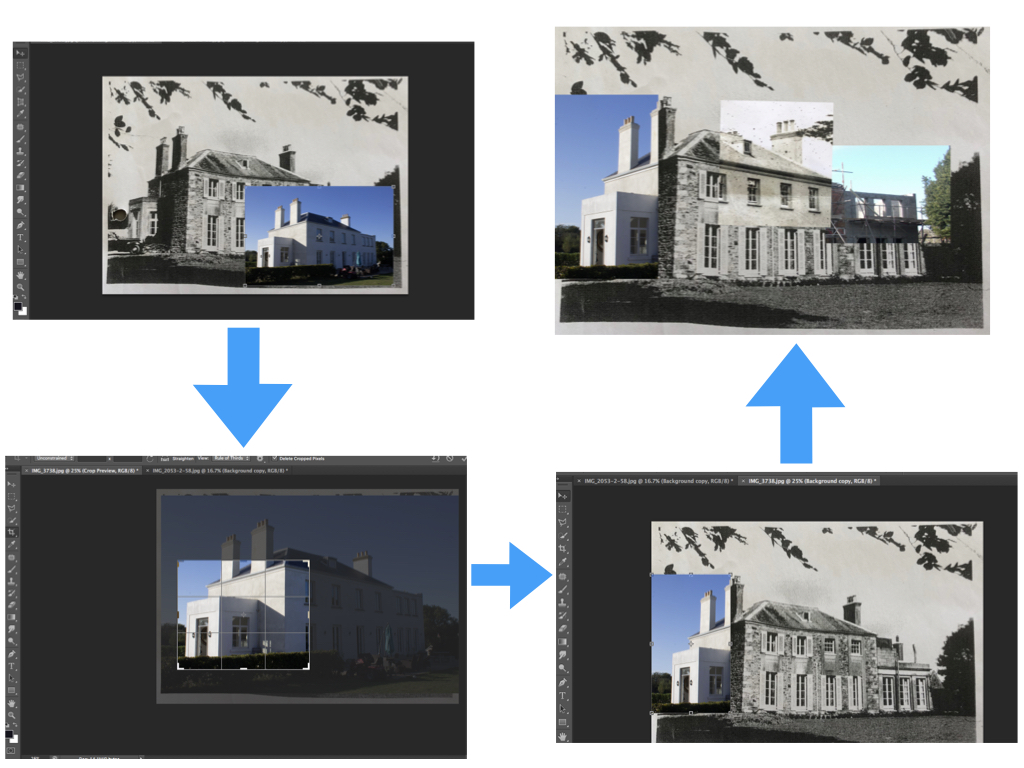
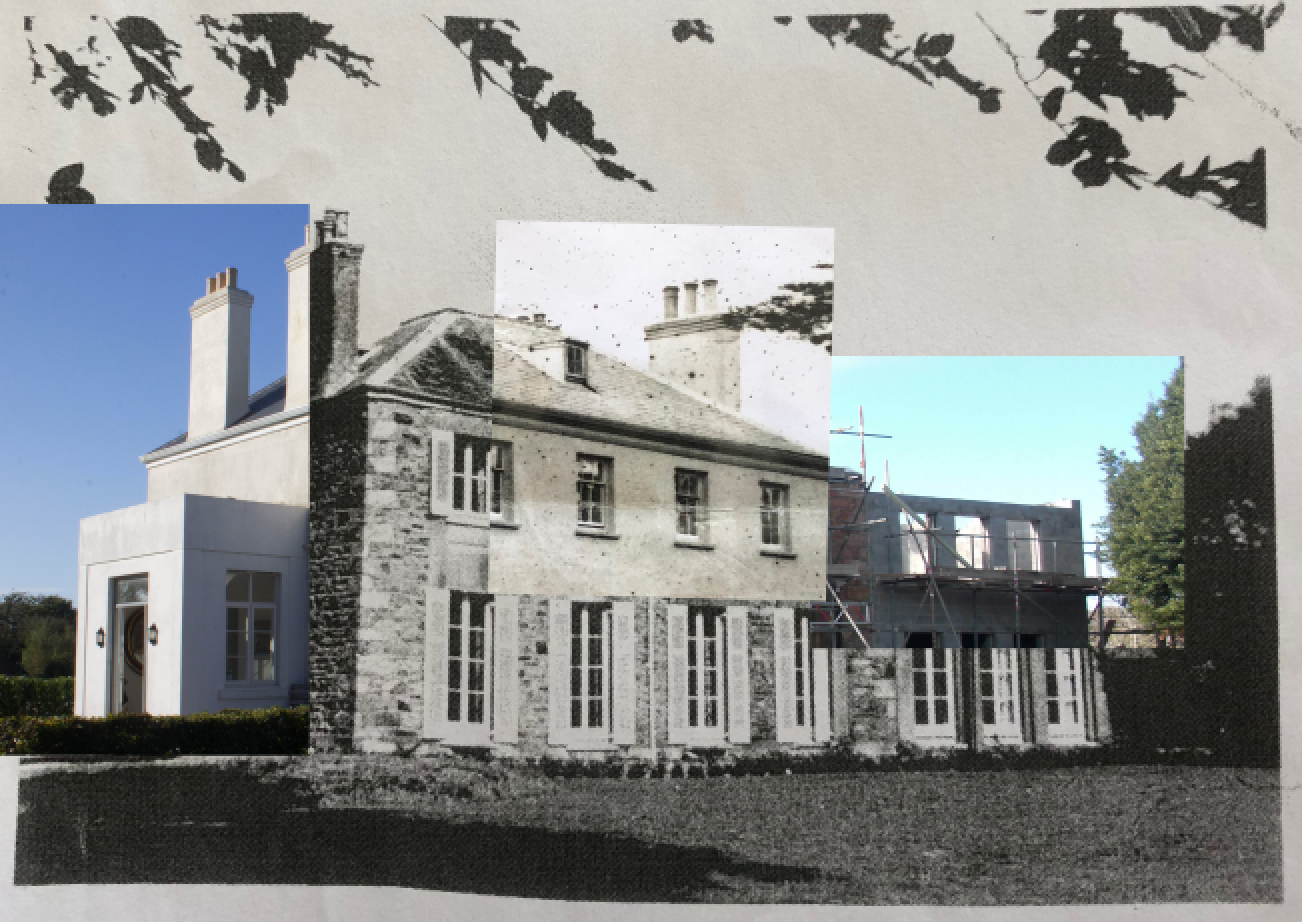
Technique 2
For this technique I will look at splitting the two photographs half and half or into thirds or quarters if there is more photographs to compare.
I will do this by first choosing a photograph to be the base photograph that the other photographs will be pasted over. I will then crop the other photographs to be roughly a half/third of the whole compostion. I will then paste the photographs onto the base photograph and look at altering them slightly to realign them in order to create a more accurate composition. As with technique 1, if I go through with this technique I will edit features such as the brightness of the photographs before hand to ensure that the photographs fit together well as well as spending more time aligning the photographs to create the most accurate collage possible.
I like this technique as it allows me to create clearly set out the contrasts and similarities over time but I feel as though this technique has a similar approach to technique 1 except that it slightly restricts what I can do with the compositions and where I can place the photographs.
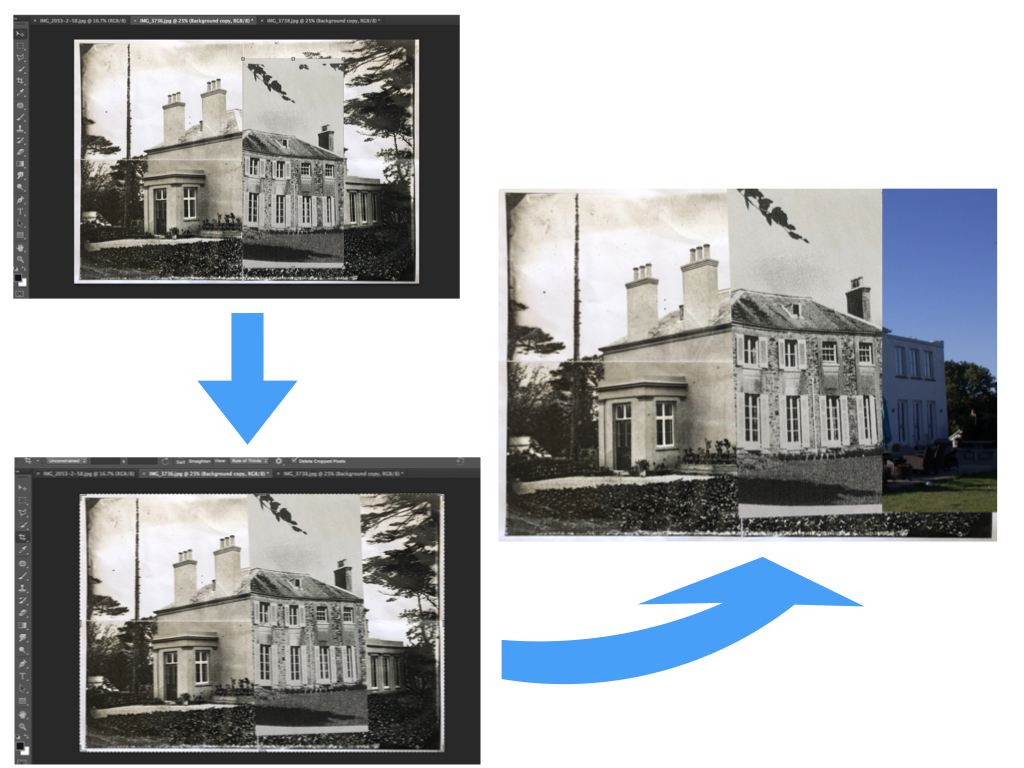
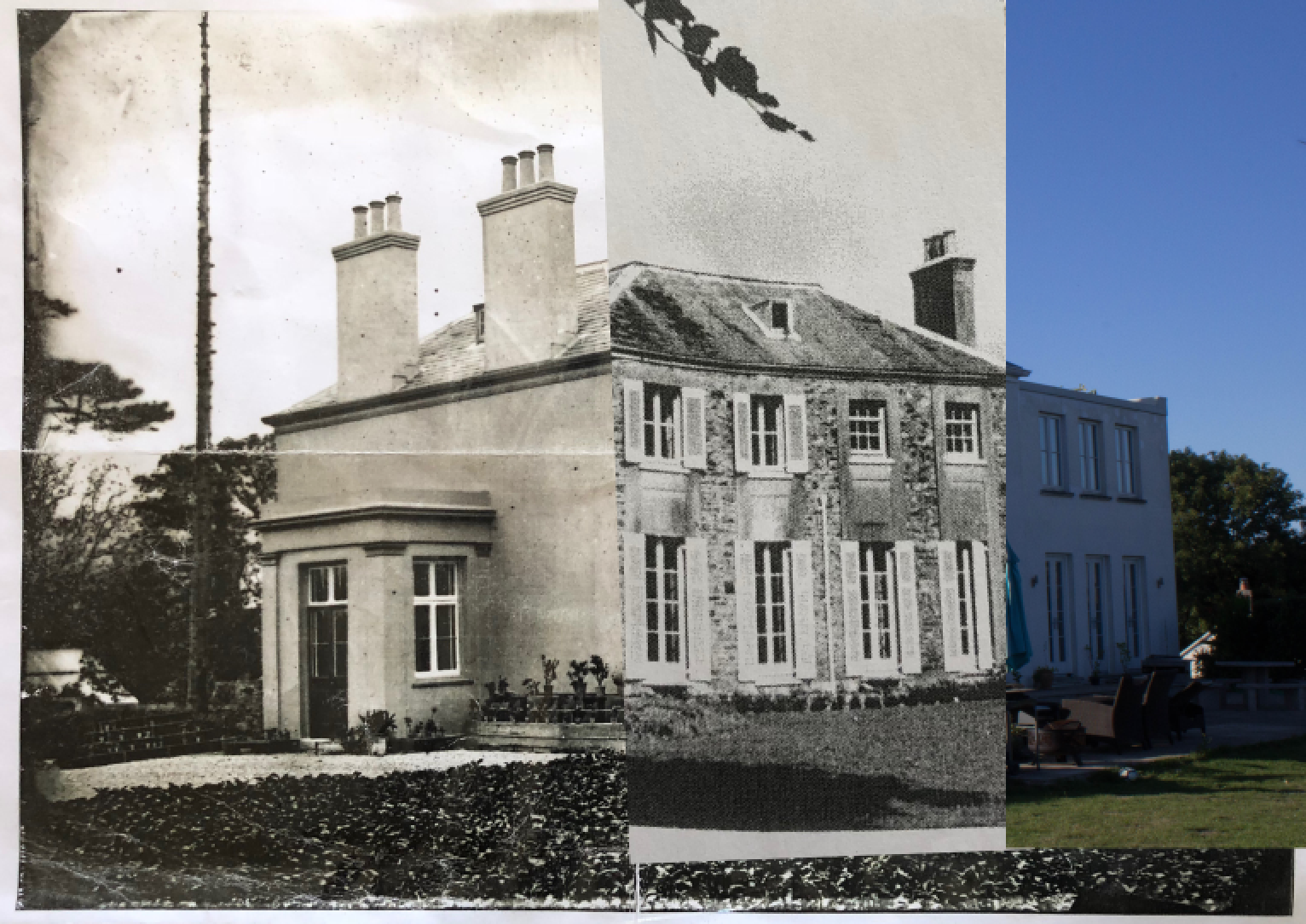
Technique 3
For this technique I will look at incorporating a more personal factor to the composition through the inclusion of how the property is being used meaning the way in which it is decorated. This gives a further insight into how the use and appearance of the property has changed throughout time. I will be taking natural frames, such as a mirror for example, and placing both archival and new photographs within the frame to give another element of how the land use has changed.
I will do this by first choosing the base photograph containing the natural framing. I will then paste the photographs chosen over the top of the base photograph and crop/alter the photographs so that they sit well in the natural frame. This will create further contrast between the old and new by showing a personal aspect of the decorations within the property.
I like this technique as it allows me to delve deeper into the use of the property and how the fashion and style of property design has changed over time. This technique can also be mixed with technique 1 as I can place the results from technique 1 into the natural frames to again add another sense of personalisation and to further show the similarities and differences that occur over time. This technique allows me to be as creative as I like with my compositions, as does technique 1, as I can place the photographs in any sequence that I choose but still create a feeling of organisation through the natural framing.
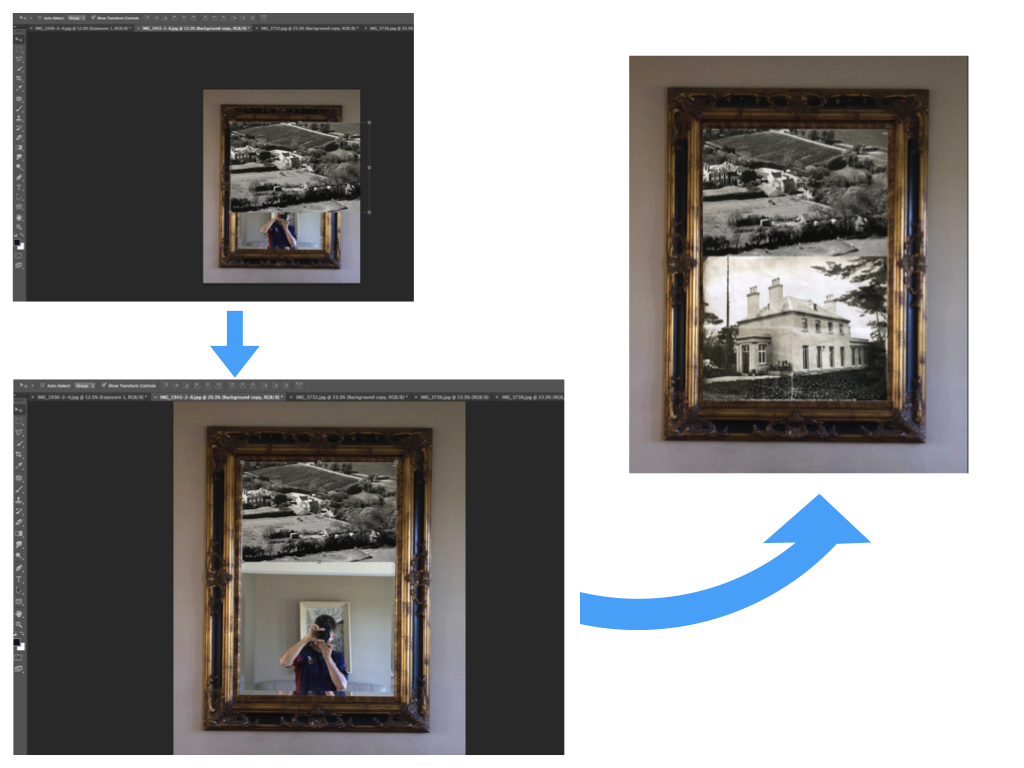
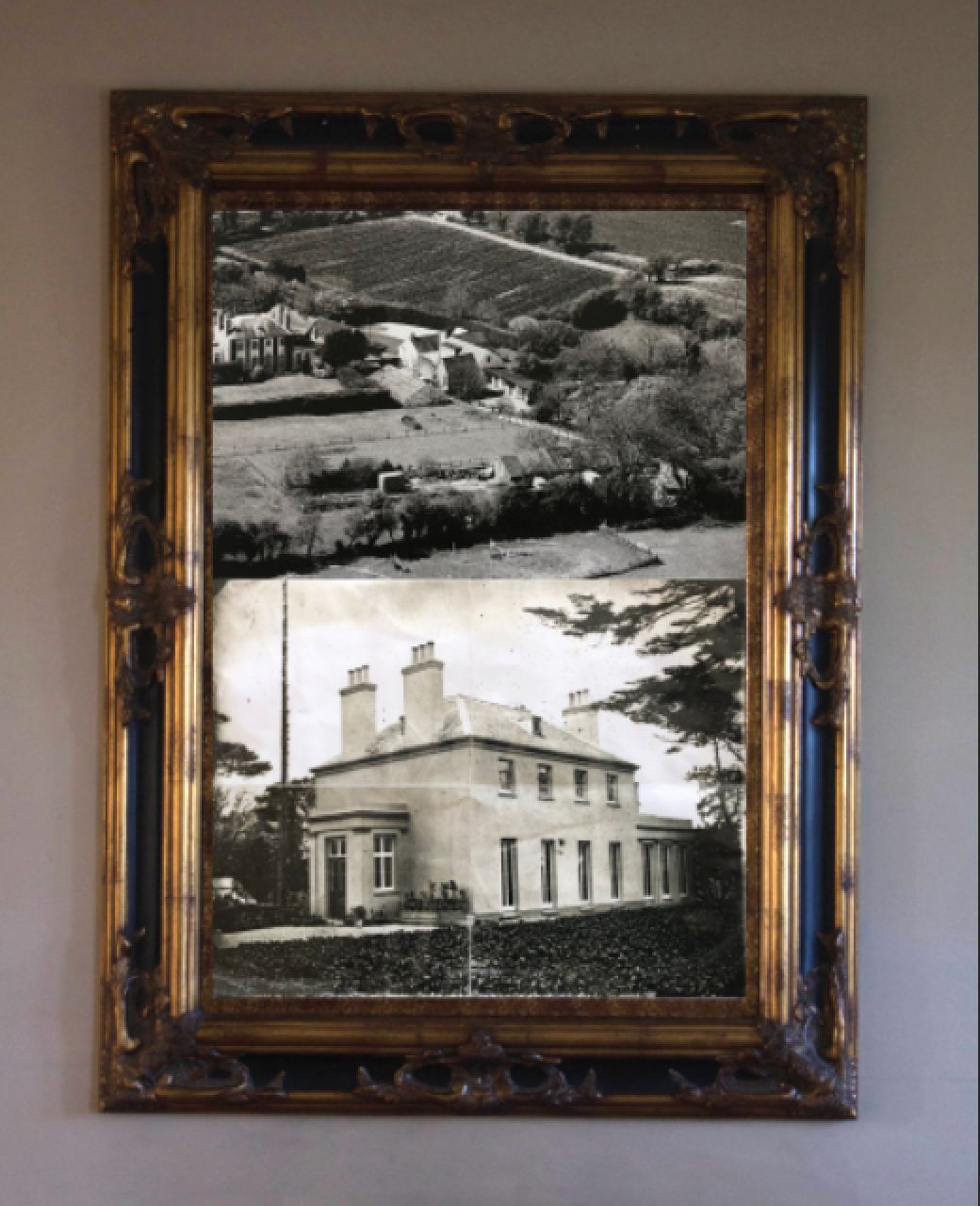
Deadline: Final Sequence
By the end of lesson on Friday 6 July you must have the following completed:
1. Import your experiments into Lightroom and add them to your collection of images that you made a sequence from last week in Lewis Bush’ workshop.
2. Re-evaluate and decide on a final sequence with a set of 6-10 images that express your own personal feelings towards the Future of St Helier.
This set of images could be made entirely of your full frame, cropped, adjusted or montaged images or a combination. The important thing is that it is a coherent set of images which communicates a specific narrative and express visually your own unique view.
Think about some of the examples that Lewis used here in his presentation.
3. Create a new collection and name it ‘Final Sequence’ under Future of St Helier in LR.

4. Export those images into a new folder named DESIGN that you create on your Media:drive as TIFF files in high-res 4000 pixels
5. Make sure you come into lesson on Mon 9 July for Workshop#4 with Lewis Bush where we will begin to design page spreads in Indesign.

Developing and Experimenting
After WORKSHOP #3 with Lewis Bush on Narrative and Sequencing it is important that you develop your set of images and experiment with different photographic techniques, approaches and styles to create more visual material that you can edit from in your final sequence of images.
Essentially we want you to develop your own visual language and create a unique set of sequenced images that reflects on how you see the Future of St Helier.
Make following blogposts with good use of visuals/images, reference to hyperlinks and analysis/ evaluations
TASKS
EVALUATE AND REFLECT
Produce a blog post where you evaluate your first sequence of images, reflect on what story you are trying to communicate and what you discussed with Lewis in terms of how you can improve and develop your project from here.
Follow Lewis’ instructions here:
- Edit 6-10 images down to an ordered series of 6-10 images
- Thinks about start, middle and end images
- Think about your theme or subject
- What happens or changes over the series of images?
- Are you using your best images?
Next:
Share your series of images with someone else.
- Can they figure out what the images are about and what is happening over the course of the series?
- Do they have any suggestions to make things clearer?
- Do a further edit based on their comments
Here is Lewis Bush’ PPT on Hautlieu Editing_reduced
DEVELOP AND EXPERIMENT
On Thursday (28 June) and Friday (29 June) you are working in the class room independently. Produce one blog post for each experiment below
Export your sequence of 6-10 images from Lightroom in high-res tiff files (4000 pixles) and save in your EDIT folder
Experiment 1: CROPPING – complete by Fri 29 June
Using cropping tool only begin to make some radical changes by selecting areas of your images for a different visual impact. Produce at least 3 different crops for 6 images.
One of the founding fathers of Documentary Photography Walker Evans used cropping as part of his work. Another pioneer of the photo-essay, W. Eugene Smith also experimented with cropping is his picture-stories
Read more here on Walker Evans and his magazine work and his series Labour Anonymous here on W. Eugene Smith.
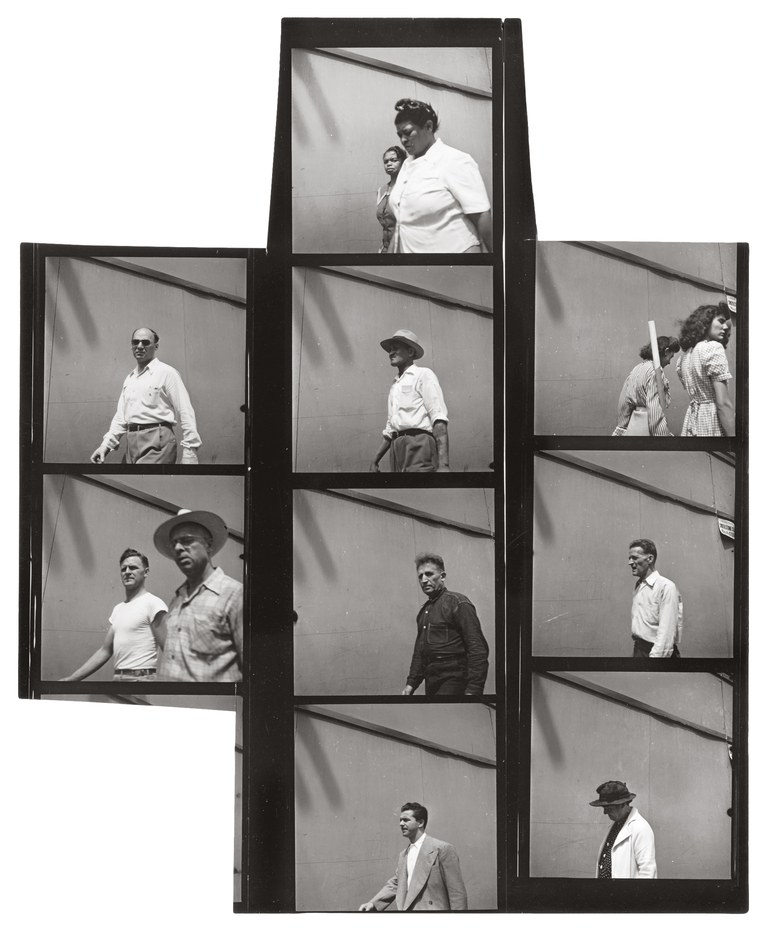
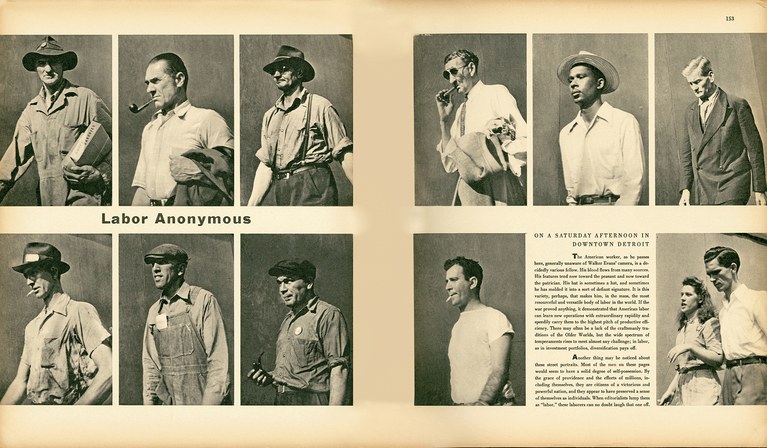
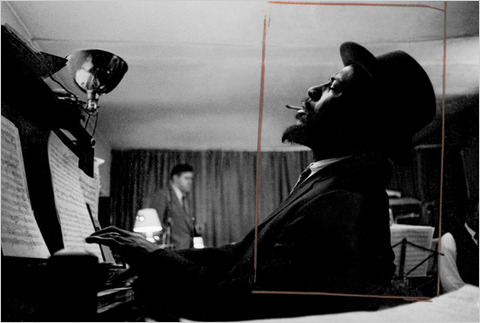
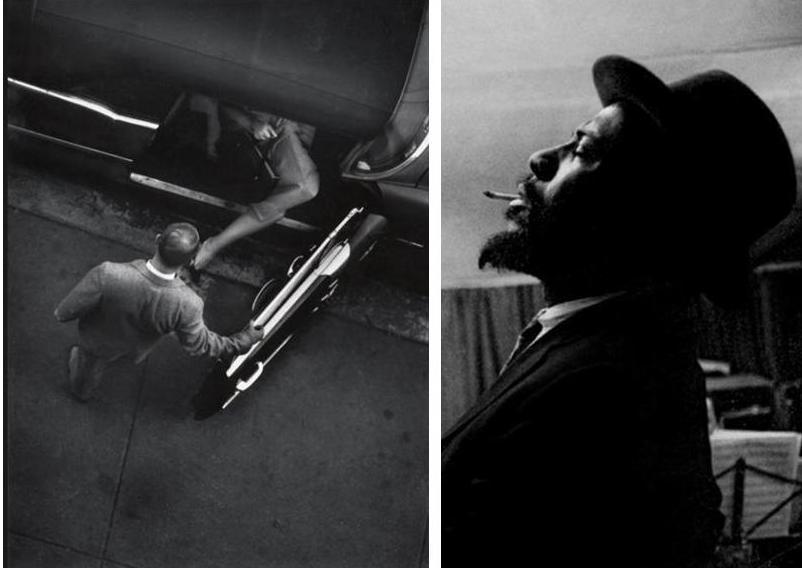
Experiment 2: COLOUR > B&W ADJUSTMENTS complete by Fri 29 June
Using your tools such as White Balance / Exposure / Levels / Curves / Brightness /Contrasts / Colour Balance / Hue / Saturation / Colour overlay and make radical changes to the overall aesthetic of the images. Try and adjust images according to your visceral quality – relating to your deep inward feelings rather than how something looks! Produce 3 different adjustments with images
Look at the publication Global Market by students are ECAL for inspiration. Go to this folder for high-res images of the page-spreads.


Experiment 3: MONTAGE > COMPOSITE IMAGES complete by Wed 4 July
Using your skills in Photoshop that you learned at AS begin to work with different montage / collage / cut n past/ composite / Layers / Masks / Opacity / Blending modes / Brush techniques
1. Use your selected images and produce at least 3 different collages combining two or more images / people / landscapes / text / typography / colour / shapes / textures/
2. Combine your images with images from the Photo-Archive that relate to your area in town. Go to the folder below and choose at least 3 high-res images from selected photographers, Percival Dunham, Ernest Baudoux, Albert Smith and Francis Foot
M:\Departments\Photography\Students\Future of St Helier\SJ Photo-Archive
3. Print out 1 of your own images and 1 archive images on the Laserjet and manipulate the prints by destroying it in 5 different ways and re-configure using scissors / tape / cut-n-paste / glue. Try and manipulate the printed images using your body / hand/ face etc .


Look at Jonny Briggs for visual inspiration
Read more here
RE-VISIT AND RE-SHOOT – complete by Mon 2 July
Here are few things to consider for your second shoot
- Revisit location and make another shoot. Reflect on your current sequence of images and think about what is missing, or what you need to photograph to add value to the story you are trying to communicate.
- Collect ephemera / found objects and photograph them in-situ – how and where you found them and also re-photograph the objects as a still-life at home setting up up your own mini-studio or use Photo-studio in school.
Richard Wentworth 
Lorenzo Vitturi Dalston Anatomy Keith Arnatt, Canned Sunsets, 1990-91 - Record sounds or video as another visual layer / audio ambience that you could incorporate into your project e.g select individual frames from video and edit as a sequence in a time line. Use audio to record conversation with people you meet or use it as dictaphone to record your own feelings in a diary form.
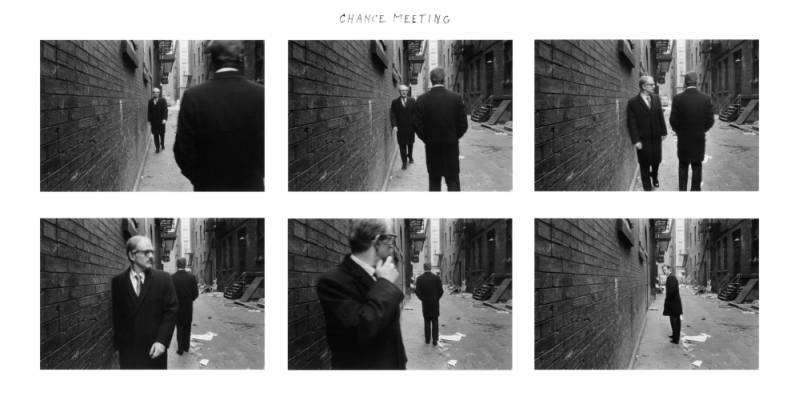
Duane Michaels 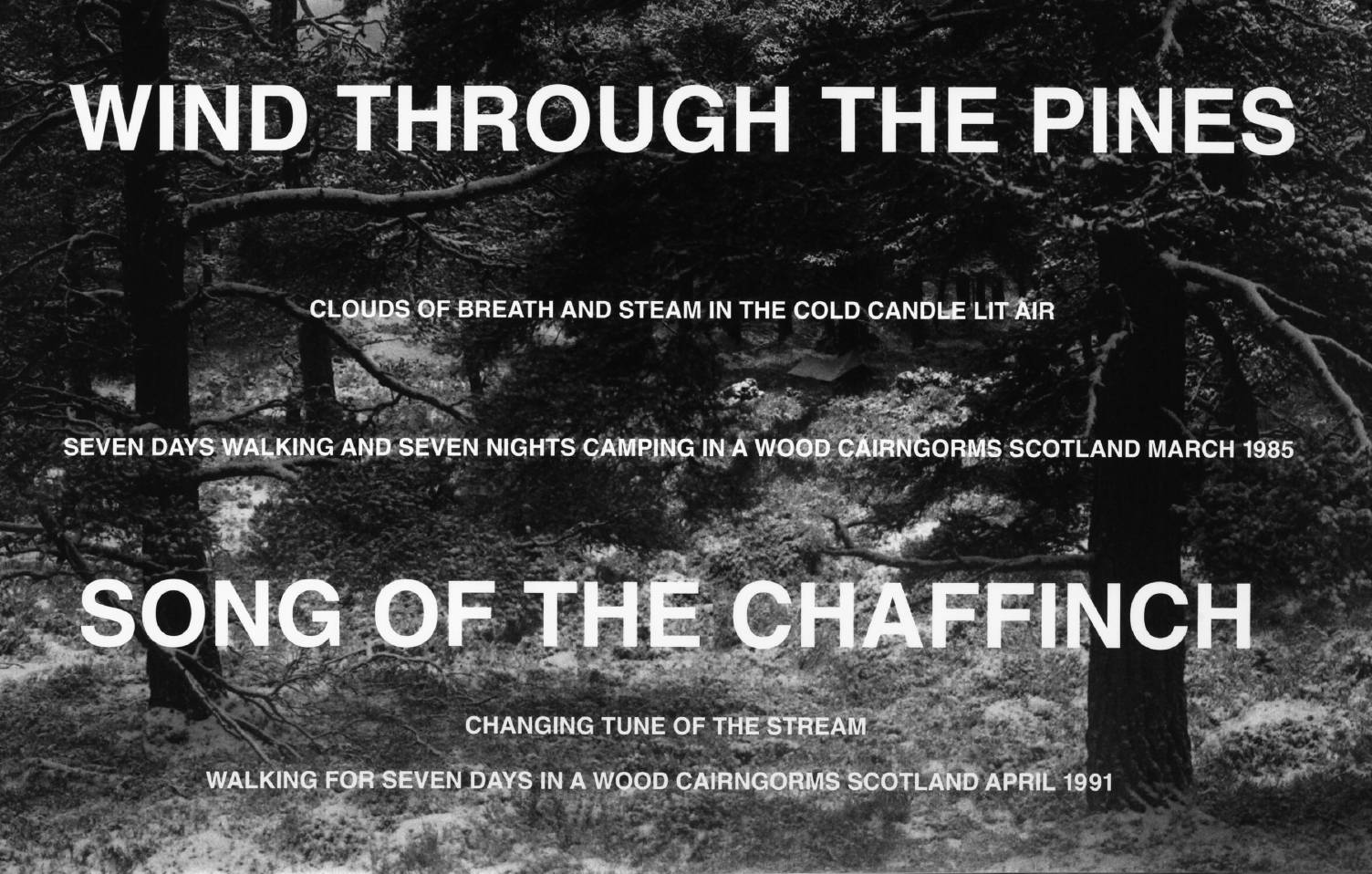
Wind through the Pines 1985, 1991 Hamish Fulton
Here is a few pointers – but not exclusive – please add your own thoughts/ ideas/ concepts/ brainstorm etc.
- Diverse communities / social groups
- Architecture / Housing
- Psycho-geography / dérive(urban drifting)
- Abstract visions…alternative, “wrong” photographs
- Formalism…line, shape, pattern, tone, colour etc
- Romanticism in the city…atmospherics
- People / 3 x types of portrait (observatinal , formal, environmental)
- Streets and capturing a momemt
- Objects | Ephemera (litter and debris)
- Make use of your senses : see , hear ,taste, smell, touch
- Old vs New vs Development
- Good vs bad…subjective approach
- Form vs function
- Gentrification vs dereliction
- Juxtaposition | contrasts | diversity
- Unconventional beauty
- Signage and facades
- Typography and graphics
- Movement / clutter
- Aerial Imagery / Satellite / Surveillance
- Angles | Viewpoints
- Environment / pollution
- Poetic / personal point of view
- roads / paths/ walkways
- Open space / Public realm
- Objects / Ephemera
However, it is important to allow for spontaneity and let you be inspired by the area you are photographing, or be inspired by people you meet in the community.
A sense of risk and an opportunity to go beyond the norm or unexpected is encouraged.



